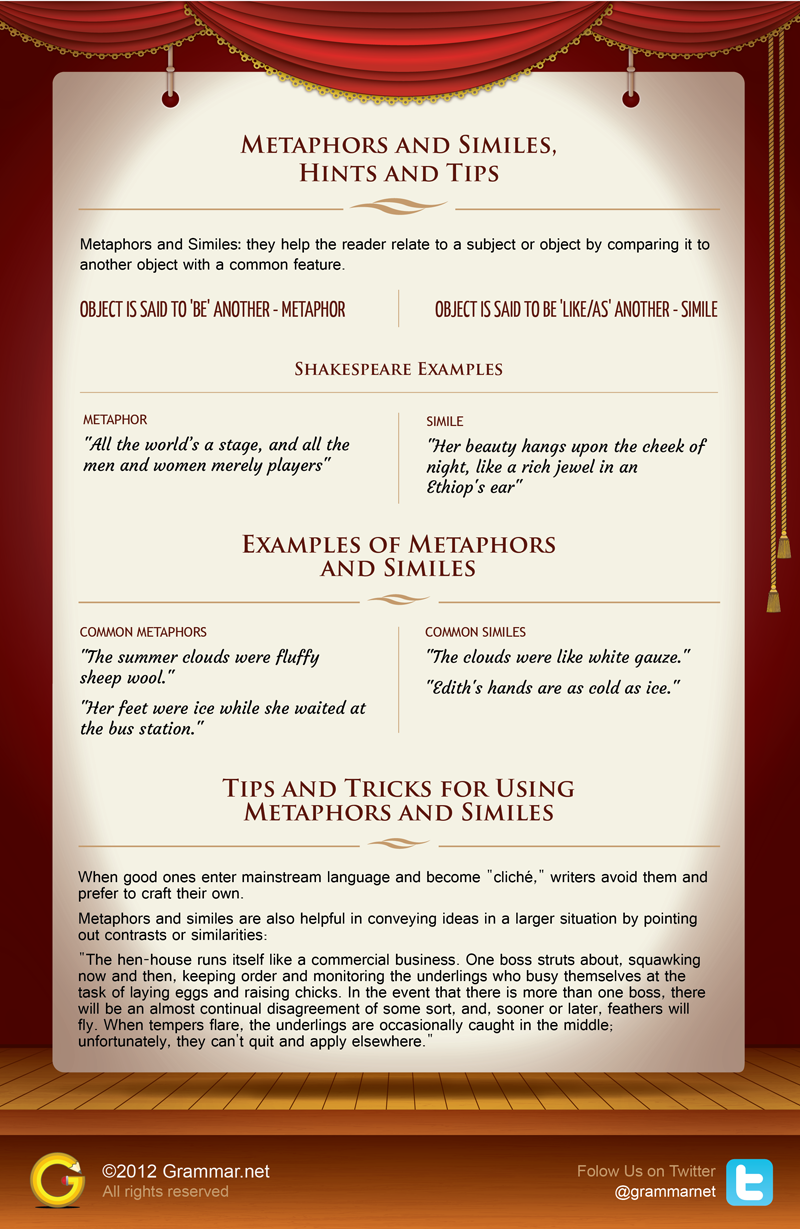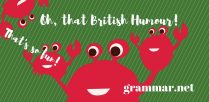What are Metaphors and Similes?
Metaphors and similes are great tools to help the reader relate to a subject or object by comparing it to another object with a common feature. When an object is said to “be” another, this is a metaphor, and when an object is said to be “like” or “as” another, this is a simile.
Shakespeare was fond of metaphors and similes. “All the world’s a stage, and all the men and women merely players” is a metaphor. “Her beauty hangs upon the cheek of night, like a rich jewel in an Ethiop’s ear” is a simile.
Embed this image to your site:
To download high-resolution poster click here
Examples of Metaphors and Similes
Common metaphors:
“The summer clouds were fluffy sheep wool.”
“Her feet were ice while she waited at the bus station.”
“Your dog is a pig.”
Common similes:
“The clouds were like white gauze.”
“Edith’s hands are as cold as ice.”
“Your dog eats like a pig.”
Consider the first example in each set. The comparisons are very basic; sheep wool is white and fluffy like clouds, and gauze is transparent. The second set is just as basic, singling out ice as a universal symbol of coldness.
The last example in each set begins to show how tricky metaphors can be. That poor, ridiculed dog is either pink and hairless, covered in mud and filthy, or he has a huge appetite. The simile better explains the intended idea.
Tips and Tricks for using Metaphors and Similes
The down side of metaphors and similes is that a particularly good one can enter mainstream language and become “cliché,” so most writers prefer to craft their own, avoiding anything regularly heard in conversation. All of the above examples are fairly common; any writer worth his salt would avoid liberal use of them, if he decided to use them at all.
If it is to be of any help, the comparison in a simile or metaphor must be very obvious. “Hairy as a tarantula” or “as dry as a walk in the Sahara” are both effective, but “happy as a cat” tells nothing. Change the last to “happy as a cat with a mouse” and it will make sense.
Metaphors and similes are also helpful in conveying ideas in a larger situation by pointing out contrasts or similarities.
“The hen-house runs itself like a commercial business. One boss struts about, squawking now and then, keeping order and monitoring the underlings who busy themselves at the task of laying eggs and raising chicks. In the event that there is more than one boss, there will be an almost continual disagreement of some sort, and, sooner or later, feathers will fly. When tempers flare, the underlings are occasionally caught in the middle; unfortunately, they can’t quit and apply elsewhere.”
Just for fun, try constructing unique metaphors and similes with random objects using this simple method.
Topic: “My daughter needs a bath because she is very dirty.”
Random, unrelated object: an apple.
An extremely dirty place: a pig pen.
Result: “My daughter needs a bath; she is as dirty as an apple in a pig pen.”
Topic: “I drove to work fast because I was late.”
Random, unrelated object: a cracker.
A place where things move quickly: a hurricane.
Result: “I was late to work, so I drove quicker than a cracker in a hurricane.”
Topic: “Maggie felt awkward at the dance.”
Random, unrelated object: a bowling ball.
A place where people socialize: a picnic.
Result: “Maggie felt as out of place as a bowling ball at a picnic.”
Were you able to invent any unique metaphors or similes? Please post them!



![10 Idioms About Food [infographic]](https://www.grammar.net/wp-content/uploads/2012/10/10-food-idioms_small-308x95.png)
![Thanksgiving vocabulary: gobble-gobble [infographic]](https://www.grammar.net/wp-content/uploads/2012/10/Thanksgiving_small-308x95.png)



